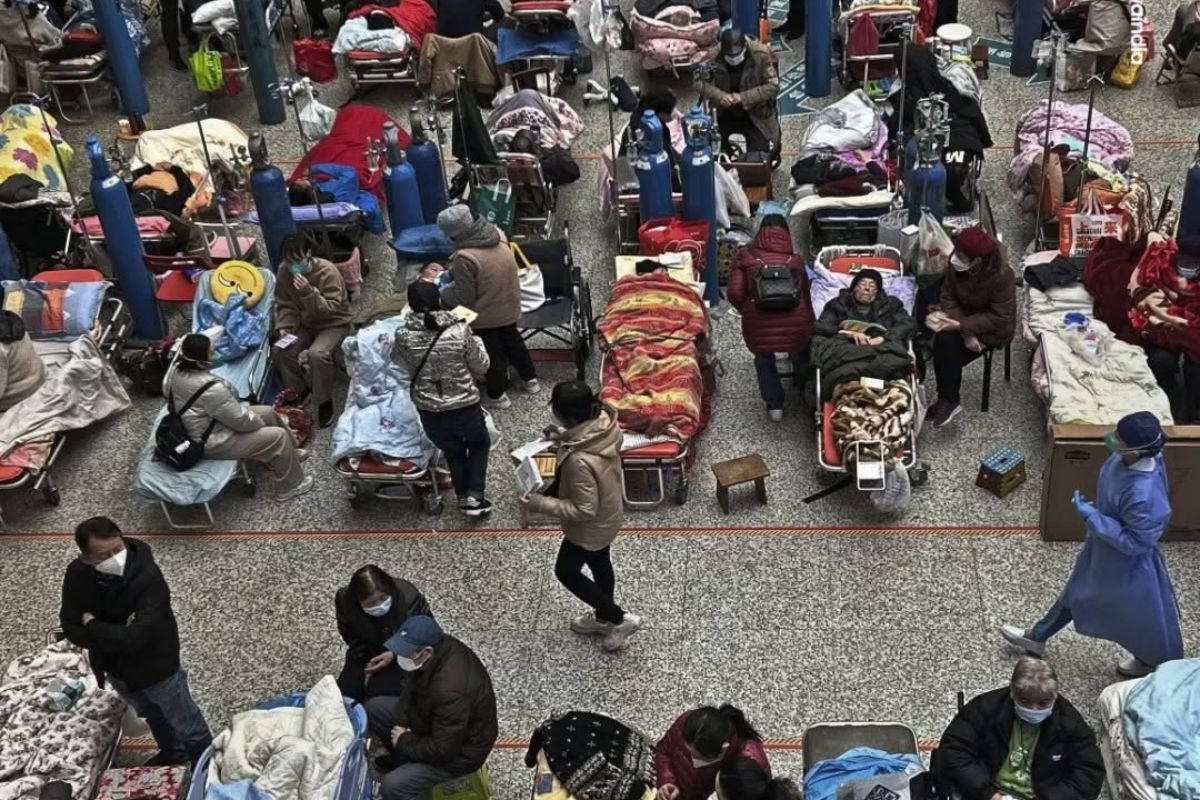Five years following the COVID-19 epidemic, China is now dealing with a human metapneumovirus (HMPV) epidemic. Claiming overloaded hospitals and crematories, reports and social media posts point to a fast virus spread. Online videos show packed hospitals where people propose the concurrent circulation of several viruses, including influenza A, HMPV, Mycoplasma pneumoniae, and COVID-19. Notwithstanding these accounts, no formal certification of a state of emergency has been provided. Known to generate flu-like symptoms, HMPV can also show like COVID-19. As the illness is spreading, health authorities are keeping constant observation of the circumstances.
Concerns Rise as HMPV Spreads Across Asia
China’s rising respiratory disease count has caused overworked healthcare facilities and packed hospitals. The respiratory virus HMPV, which affects various Asian nations, worries health authorities especially about its spread. China’s health authorities claim that the virus is currently spreading over the northern areas; the Chinese Centre for Disease Control and Prevention agrees that northern China is the most severely afflicted.
Most common in youngsters, HMPV—which can affect persons of all ages—raises more public health issues. While social media reports show a dire scenario, neither Chinese officials nor the World Health Organisation (WHO) has so yet proclaimed a state of emergency.
岩屋毅外務大臣の更迭を求めます#岩屋売国大臣の勝手な売国を許さない
中国で呼吸器感染症の「HMPVウイルス」が急増、病院が満員になっている現状
これから中国が旧正月になって中国人
観光客が日本にきて感染拡大したらどうしてくれるんですか?
pic.twitter.com/RKoOuHdXgw— サキガケ (@nihonpatriot) December 29, 2024
No Vaccine Yet for Virus Discovered 20 Years Ago
Given the virus is known for about two decades yet there is no vaccination for HMPV, the epidemic has raised awareness of the importance of preventative actions. To stop the infection from spreading, health professionals advise public health rules’ observance and alertness. The public has been warned by authorities to maintain proper hygienic practices including frequent hand washing and mask donning.
Neighbouring areas are keeping close eye on the virus’s dissemination. For example, Hong Kong has recorded very few instances, whereas the health authorities of Japan are handling a major flu epidemic with thousands of cases recorded all around.
Understanding Human Metapneumovirus (HMPV)
Comprising the Pneumoviridae family, human metapneumovirus (HMPV) is an encapsulated single-stranded negative-sense RNA virus. First found in 2001 by Dutch researchers in samples from children with respiratory infections, serological tests point to it being a widespread respiratory pathogen having at least 60 years of existence globally.


Death Rates and Susceptible Populations
Particularly vulnerable to HMPV are children, immunocompromised people, and the elderly; they also have increased chance of co-infections with other respiratory viruses. Though in severe situations HMPV can occasionally cause bronchitis and pneumonia, it usually causes ordinary cold symptoms including cough, fever, nasal congestion, and wheezing.
HMPV infection can be deadly in those having underlying medical disorders. HMPV accounts about 1% of acute lower respiratory infection-related mortality in children under five, according data from a 2021 article in The Lancet Global Health. There is not a vaccination or strong medication against HMPV at the moment; treatment mostly aims to reduce symptoms.
Viral Videos of Crowded Hospitals Trigger Speculation
Social media has seen videos depicting Chinese hospitals being overrun by the HMPV epidemic. These accounts imply that several viral outbreaks have left cemeteries and hospitals packed. These together with HMPV are influenza A, Mycoplasma pneumoniae, and COVID-19. Five years after COVID-19 brought life to a stop, another epidemic looms large and causes terror online. It is noteworthy, nevertheless, that no reputable source has validated these postings.
Hospitals in China Overwhelmed as Severe “Flu” Outbreak, Including Influenza A and HMPV, Resembling 2020 COVID Surge. pic.twitter.com/GWw9u6JxsX
— Boar News (@PhamDuyHien9) December 29, 2024
Neither Chinese health officials nor the World Health Organisation (WHO) have acknowledged the presence of a fresh epidemic or provided any advise to individuals to exercise care. Against all the conjecture, the WHO has not declared an emergency.
BREAKING:
Hospitals in China
Overwhelmed as Severe “Flu” Outbreak, Including Influenza A and HMPV, Resembling 2020 COVID Surge.
Hospitals in China are overwhelmed as outbreaks of “influenza A” and “human metapneumovirus” resemble the COVID-19 surge from three years ago. pic.twitter.com/mPF6XGjQCY
— SARS‑CoV‑2 (COVID-19) (@COVID19_disease) December 28, 2024
Preventive Measures and Public Health Recommendations
Given the present circumstances, health professionals advise the following preventive actions to lower the HMPV infection risk:
- Personal cleanliness: hand hygiene Wash hands with soap and water often for at least twenty seconds.
- Etiquette for Breathing: When coughing or sneezing, cover nose and mouth with a tissue or elbow.
- Avoid Close Contact: Keep your distance from anyone showing respiratory disease.
- Stay Home When Sick: If you are sick, remain home to stop the infection from being shared to others.
- Disinfect Surfaces: Clean and sterilise often handled surfaces and objects regularly.
Following these rules will help people stop HMPV from spreading and guard sensitive groups against serious respiratory problems.
















